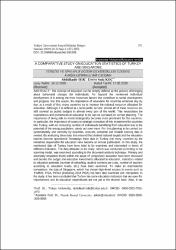| dc.contributor.author | Işık, Abdülkadir | |
| dc.contributor.author | Koç, Seda | |
| dc.date.accessioned | 2022-05-11T14:47:11Z | |
| dc.date.available | 2022-05-11T14:47:11Z | |
| dc.date.issued | 2020 | |
| dc.identifier.issn | 1305-7766 | |
| dc.identifier.issn | 2587-2451 | |
| dc.identifier.uri | https://doi.org/10.26468/trakyasobed.661538 | |
| dc.identifier.uri | https://app.trdizin.gov.tr/makale/TkRFMk16TXdNQT09 | |
| dc.identifier.uri | https://hdl.handle.net/20.500.11776/10451 | |
| dc.description.abstract | The concept of education can be simply defined as the process of bringing about behavioral changes for individuals. Far beyond the mentioned individual development, it is among the most important factors that contribute to social development and progress. For this reason, the importance of education for countries enhances day byday; as a result of this, many countries try to increase the national resources allocated for education. Although it is defined as a semi-public service, almost all of these resources are still covered by public budgets in almost every part of the world. This necessitates the expenditures and investments in education to be carried out based on correct planning.The importance of being able to invest strategically becomes more prominent for the countries. In particular, the importance of access to strategicexecution of this investment for countries like Turkey, with an increasing number of individuals benefiting from education due to the potential of the young population, stands out even more. For this planning to be carried out systematically and correctlyby countries, accurate, complete and reliable training data is needed. By analyzing these data, it is ensured that desired national targets and the education reaches become operational. Nowadays these data in Turkey and many countries by the ministries responsible for education have become an annual publication. In this study, the mentioned data of Turkey have been tried to be examined and interpreted in terms of different indicators. The data obtained in the study, which wasconducted according to the scanning model,was examined according to the document analysis technique. Primary and secondary education levels within the scope of compulsory education have been discussed and besides the budget and education investments allocated to education, indicators related to education potential (number of schooling, student numbers per class, number of teachers according to education levels, etc.) have been examined. To make an international comparison, the data of Singapore, which has shown high-level success in exams such as TIMMS, PISA, PIRLS (including 2018 PISA) has been also examined and interpreted. In the study, it has been concluded that Turkey has some education indicators that are open for improvement and its education expenditures are not yet at the desired level. Also, it has ound out that the recent educational expenditures made in Singapore have a significant contribution to the quality of education and success. | en_US |
| dc.description.abstract | Eğitim kavramı, en yalın hali ile bireylerde davranış değişikliği meydana getirme süreci olarak tanımlanmaktadır. Günümüzde ise, eğitim bahsedilen bireysel değişimin çok ötesinde, sosyal gelişime ve ilerlemeye katkıda bulunan en önemli faktörler arasında yer almakta; dolayısıyla eğitimin ülkeler için önemi günden güne artmaktadır. Bu durumunun beklendik bir sonucu olarak, birçok ülke eğitime ayrılan ulusal kaynaklarını artırmaya çalışmaktadır. Eğitim hizmetleri yarı kamusal hizmetler olarak tanımlansa da,bu hizmetler için kullanılan kaynakların neredeyse tamamı halen dünyanın hemen her yerinde kamu bütçeleri tarafından karşılanmaktadır.Bu durum, yapılan eğitim harcamalarının ve yatırımlarının doğru planlamaya dayanarak gerçekleştirilmesini gerektirmektedir. Ülkeler tarafından yapılan harcamaların ve yatırımların bir strateji çerçevesinde gerçekleştirilebilmesi giderek önem kazanmaktadır. Özellikle, genç nüfus potansiyeli nedeniyle eğitimden yararlanan birey sayısının her geçen gün arttığı Türkiye gibi ülkeler için bu yatırımın sistematik olarak yürütülebilmesinin önemi daha da belirginleşmektedir. Ülkelerin ifade edilmiş olan planlamaları doğru bir şekilde gerçekleştirilebilmesi için eksiksiz ve güvenilir eğitim verilerine ihtiyaç duyulmaktadır. Bu verilerin analiz edilmesi, ülkelerce belirlenen ulusal hedefler ve eğitim çıktılarına ulaşılabilmesi adına önem taşımakta; eğitim süreçlerine işlevsellik kazandırmaktadır. İhtiyaç duyulan bu veriler artık Türkiye'de ve pek çok ülkede eğitimden sorumlu bakanlıklar tarafından yıllık olarak yayınlanmaktadır. Bu çalışmada Türkiye'ye ait söz konusu veriler farklı göstergeler açısından incelenmeye ve yorumlanmaya çalışılmıştır. Tarama modeline göre yürütülen çalışmada elde edilen veriler doküman analizi tekniği incelenmiştir. Çalışmada zorunlu eğitim kapsamındaki ilköğretim ve ortaöğretim düzeyleri ele alınmış olup eğitime tahsis edilen bütçe ve eğitim yatırımlarının yanı sıra eğitim potansiyeli ile ilgili göstergeler (okul sayısı, sınıf başına öğrenci sayısı, eğitim seviyelerine göre öğretmen sayısı vb.) ele alınmıştır. Uluslararası bir karşılaştırma yapılabilmesi için, TIMMS, PISA, PIRLS (2018 PISA dahil) gibi sınavlarda yüksek başarı gösteren Singapur’a ait veriler de incelenmiş ve yorumlanmıştır. Araştırmada, Türkiye'nin geliştirilmeye açık bazı eğitim göstergelerine sahip olduğu ve eğitim harcamalarının henüz istenen düzeyde olmadığı sonucuna varılmıştır. Ayrıca, Singapur'da yapılan son eğitim harcamalarının eğitim ve başarı kalitesine önemli bir katkı sağlamışolduğu bulunmuştur. | en_US |
| dc.language.iso | eng | en_US |
| dc.identifier.doi | 10.26468/trakyasobed.661538 | |
| dc.rights | info:eu-repo/semantics/openAccess | en_US |
| dc.title | A Comparative Study on Education Statistics of Turkey and Singapore | en_US |
| dc.title.alternative | Türkiye ve Singapur Eğitim İstatistikleri Üzerine Karşılaştırmalı Bir Çalışma | en_US |
| dc.type | article | en_US |
| dc.relation.ispartof | Trakya Üniversitesi Sosyal Bilimler Dergisi | en_US |
| dc.department | Meslek Yüksekokulları, Sağlık Hizmetleri Meslek Yüksekokulu, Çocuk Bakımı ve Gençlik Hizmetleri Bölümü | en_US |
| dc.identifier.volume | 22 | en_US |
| dc.identifier.issue | 1 | en_US |
| dc.identifier.startpage | 371 | en_US |
| dc.identifier.endpage | 387 | en_US |
| dc.institutionauthor | Koç, Seda | |
| dc.identifier.trdizinid | TkRFMk16TXdNQT09 | en_US |



















